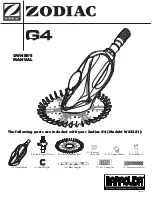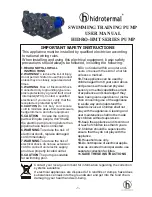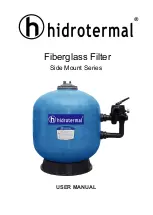
Preparation
Installation of small swimming pool usually takes only 10 minutes with 1 people
Recommendations regarding placement of the pool:
• It is essential the pool is set up on solid, level ground. If the pool is set up on
uneven ground it can cause collapse of the pool and flooding, causing serious
personal injury and/or damage to personal property. Setting up on uneven ground
will void the warranty and service claims.
• Do not set up on driveways, decks, platforms, gravel or asphalt. Ground should be
firm enough to withstand the pressure of the water; mud, sand, soft / loose soil or
tar are not suitable.
• The ground must be cleared of all objects and debris including stones and twigs.
• Check with your local city council for by-laws relating to fencing, barriers, lighting
and safety requirements and ensure you comply with all laws.
Installation
Assembly can be completed without tools.
NOTE: It is important to assemble pool in the order shown below. Adult assembly
required.
1. Find solid, level ground and clear it of debris.
Attention: Do not set up the pool under cables or under trees.
2. Spread out the pool and make sure it is right side up.
3. Cover the water valve.
4. Assemble the top rails, connect Top Rail A to Top Rail B, and slide into the pole
sleeve. (Fig. 1)
5. At the corners, insert the Top Rails (A & B) into the Corners (D). (Fig. 2)
6. Insert the Vertical Pool Legs (C) into the bottom of the Corners (D). (Fig. 3)
7. Attach all Footings (E) to the bottom of the Vertical Pool Legs (C). (Fig. 4)
8. Test the Frame to ensure all connections are secure before filling with water.
9. Put 1’’ to 2’’ (2 to 5cm) of water in the pool to the cover the floor. Once pool floor
is slightly covered, gently smooth out all wrinkles. Start in the center of the pool
and work your way clockwise to the outside.
10. Continue to fill the pool until reaches the water fill line located on the pool’s
interior. Please kindly pay the utmost attention not over fill the pool for security
reasons.
Dismantling
1. Open water valve on the bottom of the pool, water will drain automatically. (Check
local regulations for drainage by-laws). Then dismantle the frame of the pool to
release the water. Make sure release most of the water in 20 minutes.
Note: Drain by adult only!
2. Open the air valve on the top ring to deflate.
3. Air dry pool.
ATTENTION: Do not leave the drained pool outside.
Repair
If your pool is damaged, use the provided repair patch.
1.Completely deflate the top ring.
2.Clean and dry the damaged area.
3.Apply the repair patch and smooth out any air bubbles.
Pool Maintenance
WARNING:
If you do not adhere to the maintenance guidelines covered herein, your
health might be at risk, especially that of your children.
1. Change the water of pools frequently (particularly in hot weather) or when
noticeably contaminated, unclean water is harmful to the user’s health.
2. Please contact your local retailer to obtain chemicals to treat the water in your
pool. Be sure to follow the chemical manufacturer’s instructions.
3. Proper maintenance can maximize the life of your pool.
4. See packaging for water capacity.
Cleaning and Storage
1. After deflation, use a damp cloth to gently clean all surfaces.
Note: Never use solvents or other chemicals that may damage the product.
2. Remove all the accessories and spare parts of the pool and store them clean and
dry.
3. Once pool is completely dry, sprinkle with talcum powder to prevent pool from
sticking together, fold pool carefully. If pool is not completely dry, mould may result
and will damage the pool liner.
4. Store liner and accessories in a cool, dry place out of children’s reach, with a
moderate temperature between 5°C / 41°F and 38°C / 100°F.
5. During the rainy season, pool and accessories should be stored as instructed
above.
6. Unproper draining of the pool might cause serious personal injury and/or damage
to personal property.
7. Check the product for damage at the beginning of each season and at regular
intervals when in use.
Parts:
Fotografía de la estructura:
Drawings may not reflect actual product, not scaled to size.
Heavy-duty repair patch
Liner
A
B
D
E
C
B
B
B
B
D
C
D
A
A
A
A
Fig. 1
Fig. 2
Fig. 3
Fig. 4
B
A
• Children, especially children younger than 5 years, are at high risk of drowning.
• Drowning occurs silently and quickly and can occur in as little as 2 in. (5cm) of
water.
• Keep children in your direct sight, stay close, and actively supervise them when
they are in or near this pool and when you are filling and emptying this pool.
• When searching for a missing child, check the pool first, even if child is thought to
be in the house.
• Empty pool completely after each use and store the empty pool in such a way that it
does not collect water from rain or any other source.
Drowning Risk:
• Keep unsupervised children from accessing the pool by installing fencing or other
approved barrier around all sides of the pool. State or local laws or codes may
require fencing or other approved barriers. Check state or local laws and codes
before setting up the pool. Refer to the list of barrier recommendations and
guidelines as described in CPSC Publication No.362.
• Do not leave toys inside pool when finished using, since toys and similar items
might attract a child to the pool.
• Position furniture (for example, tables, chairs) away from pool and so that children
cannot climb on it to gain access to the pool.
• After using the pool, remove water to a level of 1/2 in. (1cm) or less.
Diving Risk:
• Do not dive into the pool. Diving into shallow water can result in a broken neck,
paralysis, or death.
Electrocution Risk:
• Keep all electrical lines, radios, speakers and other electrical appliances away from
the pool.
• Do not place pool near or under overhead electrical lines.
First Aid:
• Keep a working phone and a list of emergency numbers near the pool.
• Become certified in cardiopulmonary resuscitation (CPR). In the event of an
emergency, immediate use of CPR can make a life-saving difference.
Safety Barrier Guidelines for Residential Swimming Pool Section I: Outdoor
swimming pool
An outdoor swimming pool, including an inground, aboveground, or onground pool,
hot tub, or spa, should be provided with a barrier which complies with the following:
1. The top of the barrier should be at least 48 inches above grade measured on the
side of the barrier which faces away from the swimming pool. The maximum
vertical clearance between grade and the bottom of the barrier should be 4
inches measured on the side of the barrier which faces away from the swimming
pool. Where the top of the pool structure is above grade, such as an
aboveground pool, the barrier may be at ground level, such as the pool structure,
or mounted on top of the pool structure. Where the barrier is mounted on top of
the pool structure, the maximum vertical clearance between the top of the pool
structure and the bottom of the barrier should be 4 inches.
2. Openings in the barrier should not allow passage of a 4-inch diameter sphere.
3. Solid barriers, which do not have openings, such as a masonry or stone wall,
should not contain indentations or protrusions except for normal construction
tolerances and tooled masonry joints.
4. Where the barrier is composed of horizontal and vertical members and the
distance between the tops of the horizontal members is less than 45 inches, the
horizontal members should be located on the swimming pool side of the fence.
Spacing between vertical members should not exceed 1-3/4 inches in width.
Where there are decorative cutouts, spacing within the cutouts should not exceed
1-3/4 inches in width.
5. Where the barrier is composed of horizontal and vertical members and the
distance between the tops of the horizontal members is 45 inches or more,
spacing between vertical members should not exceed 4 inches. Where there are
decorative cutouts, spacing within the cutouts should not exceed 1-3/4 inches in
width.
6. Maximum mesh size for chain link fences should not exceed 1-3/4 inch square
unless the fence is provided with slats fastened at the top or the bottom which
reduce the openings to no more than 1-3/4 inches.
7. Where the barrier is composed of diagonal members, such as a lattice fence, the
maximum opening formed by the diagonal members should be no more than
1-3/4 inches.
8. Access gates to the pool should comply with Section I, Paragraphs 1 through
7,and should be equipped to accommodate alocking device. Pedestrian access
gates should open outward, away from the pool, and should be self-closing and
have a self-latching device. Gates other than pedestrian access gates should
have a self-latching device. Where the release mechanism of the self-latching
device is located less than 54 inches from the bottom of the gate, (a) the release
mechanism should be located on the pool side of the gate at least 3 inches below
the top of the gate and (b) the gate and barrier should have no opening greater
than 1/2 inch within18 inches of the release mechanism.
9. Where a wall of a dwelling serves aspart of the barrier, one of the following
should apply:
(a) All doors with direct access to the pool through that wall should be equipped
with an alarm which produces an audible warning when the door and its
screen, if present, are opened. The alarm should sound continuously for a
minimum of 30 seconds within 7 seconds after the door is opened. Alarms
should meet the requirements of UL2017 General-Purpose Signaling Devices
and Systems, Section 77. The alarm should have a minimum sound pressure
rating of 85 dBA at 10 feet and the sound of the alarm should be distinctive
from other household sounds, such as smoke alarms, telephones, and door
bells. The alarm should automatically reset under all conditions. The alarm
should be equipped with manual means, such as touchpads or switches, to
temporarily deactivate the alarm for a single opening of the door from either
direction. Such deactivation should last for nomore than 15 seconds. The
deactivation touchpads or switches should be located at least 54 inches
above the threshold of the door.
(b) The pool should be equipped with a power safety cover which complies with
ASTM F1346-91 listed below.
(c) Other means of protection, such as self-closing doors with self-latching
devices, are acceptable so long as the degree ofprotection afforded is not less
than the protection afforded by (a) or (b) described above.
10. Where an aboveground pool structure is used as a barrier or where the barrier is
mounted on top of the pool structure, and the means of access is a ladder or
steps, then (a) the ladder to the pool or steps should be capable of being
secured, locked or removed to prevent access, or (b) the ladder or steps should
be surrounded by a barrier which meets Section I, Paragraphs 1 through 9. When
the ladder or steps are secured, locked, or removed,any opening created should
not allow the passage of a 4-inch diameter sphere.
Section II: Barrier Locations
Barriers should be located so as to prohibit permanent structures, equipment or
similar objects from being used to climb the barriers.
A
B
C
D
E
4
4
4
4
4
Top Rail A
Top Rail B
Vertical Pool Leg
Corner
Footing
Ref#
Pool Size & Quantity
122cm x 122cm x 30.5cm (48” x 48” x 12”)
Description
3





































